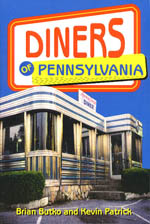- PRESS RELEASE #2 - 800 words
-
- DINER STYLES ACROSS PENNSYLVANIA EXPLORED
IN BOOK
-
- A diner is one of the few places that
appeals to a wide range of ages. Kids, teens, baby boomers, and
senior citizens all love the good food and fair prices that so
many diners provide.
-
- But the love of diners goes beyond that
- these popular restaurants offer a sense of community and the
promise of home-cooking all in a familiar-looking building. The
story of those buildings and the industry that continues to create
them is the focus of Diners of Pennsylvania by Brian Butko
and Kevin Patrick.
-
- "Pennsylvania is great for studying
diners," says Butko. "It probably has a wider cross-section
of diners than any other state." From 80-year-old diners
with barrel-shaped roofs to today's glass block and chrome giants,
diners of all styles have found their way to the Keystone state.
-
- Pennsylvania also offers a wide range
of foodways, from scrapple and shoofly pie in the east to haluski
and pierogies around Scranton and Pittsburgh.
-
- Butko says most people think diners are
just train cars turned into restaurants. "People also increasingly
think of diners only as places with chrome decor and '50s music.
But there is a rich history to diners, which for more than a
century have been built in factories specifically as restaurants."
-
- Diners trace their roots back to the late
1800s, when lunch carts appeared in New England to serve overnight
industrial workers. Kevin Patrick says that as industry spread
south, so did the manufacturers: "By the 1920s, New Jersey
and downstate New York had six producers compared to Massachusett's
four. Pennsylvania's coal and steel towns were ripe markets for
their output."
-
- A few diners from that era can still be
found, such as Pip's on Pittsburgh West End, a 1920s Teirney-brand
diner that still serves breakfast and lunch. More common are
diners made by O'Mahony. The facade of Trolley Car Café
in Lewistown blends into the streetscape but the name and a peek
around back reveal both a 1926 and 1940 O'Mahony diner.
-
- O'Mahony remained a prolific builder until
1956. Its most famous product is the very long Mayfair Diner
on Frankford Ave. in northeast Philadelphia.
-
- Many mid-century diners were made by Silk
City; two examples are the West Shore Diner in Lemoyne near Harrisburg
and the Park Dinor in Erie.
-
- The use of "dinor" is particular
to northwest Pennsylvania. "The 'dinor' spelling once dominated
restaurants in the region," says Butko. "It can still
be found on a number of diners, but no one is sure of its origin."
-
- Most of the diners remaining in Pennsylvania
were made after WWII. Among the most common makes are Fodero,
Mountain View, DeRaffele, Kullman, and Paramount. Descendants
of the last three still produce diners in styles ranging from
retro to postmodern.
-
- One of the first to adopt a retro style
was The Dining Car in Phildelphia, built in 1981 but with the
look and feel of a 1930s diner. Patrick explains, "The postmodern
look usually includes stainless steel, chrome, glass block, checkered
tiles, and neon - all common diner elements but rarely used together
in original diners. Today's heavy use of such imagery tells potential
customers that 'here's a diner but its new and will have modern
menu items.'"
-
- Remodellings to postmodern styles are
increasingly common. The New City View Diner north of Allentown,
the Yankee Doodle Diner in the Poconos, and the 5th Street Diner
north of Reading are just a few examples of how a mix of classic
materials can give a new look to an old diner.
-
- Because diners are built as mobile restaurants,
they are increasingly moved instead of being bulldozed. Having
so many diners, Pennsylvania has become a "diner export
state." Pristine examples are regularly bought and removed
by out-of-state restaurateurs who desire a classic diner. A recent
loss was the Ingleside Diner, which had been on the Lincoln Highway
in Thorndale since 1956.
-
- Better news for Pennsylvanians was the recent move of Morgan's Eastland Diner. The 1957 Mountain View-brand diner had moved from Irwin to Butler in 1976 and had to move again in 2003. It was trucked that Fall to Presque Isle in Erie to serve locals and vacationers to the recreational peninsula.
-
- Diner fans plan trips to visit the various
styles of diners, much like auto enthusiasts attend calssic car
shows. To help, Diners of Pennsylvania includes "diner
drives" which offer the best routes to see diners along
with a history lesson about why each corridor attracted so many
diners.
-
- The book also includes extended profiles
of 25 diners, and listings of 260 diners with adresses, hours,
and specialties. Diners do change owners - and even locations
- constantly, assuring that no two "diner trips" will
be the same.
-
- Diners of Pennsylvania by Brian Butko and Kevin Patrick, published by
Stackpole Books, is available at all bookstores and online booksellers.
-
- Visit http://www.brianbutko.com
to learn more about Brian Butko's other books, all published
by Stackpole, plus his forthcoming projects.
-
- ###
|



